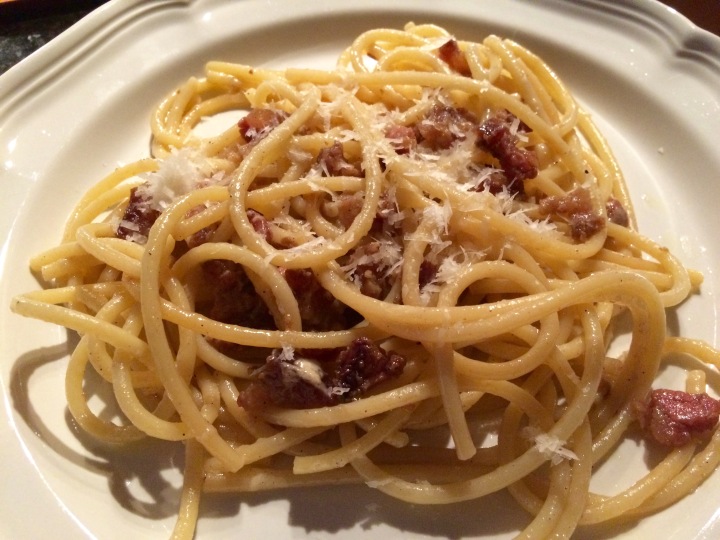My brother recently sent me a link to a Mark Bittman recipe for pasta alla gricia on The New York Times website. In his email, he wrote that he had some success with it, but wasn’t sure he had executed the recipe 100%.
Since this classic Roman pasta is one of my go-to dishes when I’m in Rome, I thought I’d try it out. But as I read through the recipe, I was surprised not to find two ingredients, which, although used sparingly, are essential to the dish: olive oil and peperoncino (Italian hot chili pepper). Their absence led me to consult David Downie’s Cooking the Roman Way, which 14 years ago provided me with my first recipe for this dish. The olive oil adds an additional layer of unctuousness to the sauce and the peperoncino, that playful heat so typical of many Roman dishes.
Ultimately, I decided to use Downie’s recipe. Bittman’s recipe, however, contained a link to a story he had written for The Times last year on Roman pasta: “For Perfect Pasta Add Water and a Vigorous Stir.” In it, he describes how a renowned Roman chef, Flavio de Maio, demonstrated for him the “magic of water,” which creates a cremina, or a sauce, which Bittman describes as “thick and round and rich” for dishes like pasta alla gricia or carbonara. Intrigued, I applied this “magical” technique of adding some pasta water to the sauce and vigorously whisking it with a fork into the cooked pasta.
This relatively simple step yielded the best version of this dish I have ever prepared, and I believe it could stand up to many that I have enjoyed abroad. One word of caution. Should you choose to follow my version, which combines Downie’s and Bittman’s, or the original Bittman recipe on the Times website, please be sure to read the above mentioned Times story, which clearly explains how to use the pasta water. Bittman rightly warns that it can be tricky and, if not done correctly, can result in a “pile of pasta with a watery sauce on top.”
Pasta Alla Gricia (Adapted from David Downie’s Cooking the Roman Way and Mark Bittman’s NY Times recipe.)

Ingredients
1/4 cup extra-virgin olive oil
1 pepperoncino (hot chile pepper), shredded or -1/4 teaspoon crushed red pepper flakes
8 ounces (about 8 1/4-inch-thick slices) guanciale, pancetta or bacon, roughly chopped
1 pound bucatini, rigatoni, or spaghetti
About 1-1/2 cups freshly grated imported Pecorino Romano
- Bring at least 5 quarts of salted water to boil in a large pot.
2. Heat the oil in a very large, high-sided frying pan over medium heat. Add the peperoncino and the guanciale and sauté, stirring until the guanciale is deeply golden, about 5 minutes.

3. Adjust the heat as necessary to render the fat without burning the meat. The meaty parts should be browned and the fatty parts should be cooked but still slightly transparent. Remove the frying pan from the heat. (For this step, I’ve included elements from both recipes. Downie says to crisp the guanciale and calls for 1 minute of cooking; but I did not find this to be enough time to render the fat from the guanciale. I also did not want the meat too crisp. Bittman calls for 15 to 20 minutes to bring the meat to a deep golden color; but this seemed a bit too much time. Finally, if your meat is very fatty, you may want to remove some of the rendered fat from the pan.)

4. Drop the pasta into boiling water and stir. Cover the pot. When the water returns to boil, cook uncovered until the pasta is barely al dente, about 1 minute less than the suggested cooking time on the package.
5. About 5 minutes before the pasta is cooked, return the frying pan to medium heat and add 1/2 to 3/4 cup of the pasta cooking water to the pan, turn the heat to high, and reduce by about half. (This and the following step are adapted from the Bittman recipe.)

6. When the pasta is ready, use tongs to transfer it to the pan with the sauce. Stir the pasta in the sauce to let it finish cooking, adding more pasta cooking water if necessary until the pasta is done and the sauce thick and creamy. Add half the cheese and a pinch of black pepper, and stir vigorously to incorporate.

7. Serve the pasta on heated plates or in bowls, passing the remaining Pecorino Romano. Makes 4 to 6 servings.

Wine Pairing: Sangiovese di Romagna, Frascati

Funny, I just posted this same recipe today! Great minds…. Yours came out better though for the simple reason that you had guanciale and I had pancetta. The former is always superior.
I agree, John. The guanciale makes a big difference. I find your use of onion interesting. I know there’s a debate about using it in amatriciana.